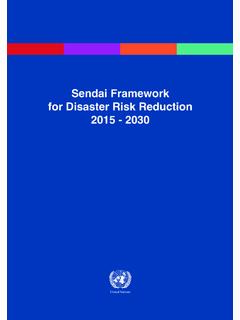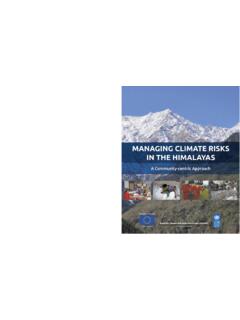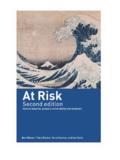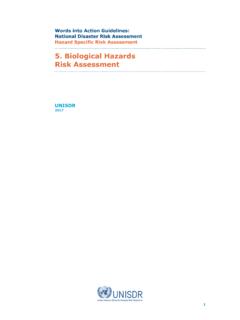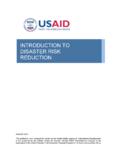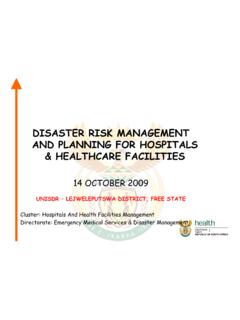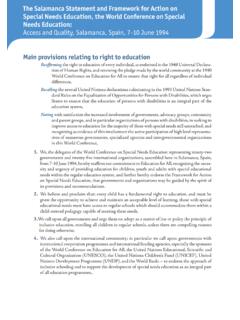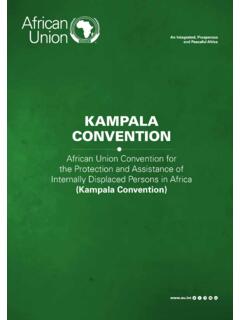Transcription of General Assembly - PreventionWeb
1 United Nations A/RES/69/283 General Assembly Distr.: General 23 June 2015 Sixty-ninth session Agenda item 19 (c) 15-08955 (E) *1508955* Please recycle resolution adopted by the General Assembly on 3 June 2015 [without reference to a Main Committee (A/69 )] 69/283. Sendai Framework for Disaster Risk Reduction 2015 2030 The General Assembly , Recalling its resolution 67/209 of 21 December 2012, in which it decided to convene, in early 2015, the Third World conference on Disaster Risk Reduction, as well as its resolutions 68/211 of 20 December 2013 and 69/219 of 19 December 2014 and its decision 69/556 of 5 March 2015, 1.
2 Expresses its profound gratitude to the Government and the people of Japan for hosting the Third United Nations World conference on Disaster Risk Reduction, from 14 to 18 March 2015, and for providing all the necessary support; 2. Endorses the Sendai Declaration and the Sendai Framework for Disaster Risk Reduction 2015 2030 adopted by the conference , which are contained in annexes I and II, respectively, to the present resolution . 92nd plenary meeting 3 June 2015 Annex I Sendai Declaration 1. We, the Heads of State and Government, ministers and delegates participating in the Third United Nations World conference on Disaster Risk Reduction, have gathered from 14 to 18 March 2015 in Sendai City, Miyagi Prefecture, Japan, which has demonstrated a vibrant recovery from the great east Japan earthquake in March 2011.
3 Recognizing the increasing impact of disasters and their complexity in many parts of the world, we declare our determination to enhance our efforts to strengthen disaster risk reduction to reduce losses of lives and assets from disasters worldwide. 2. We value the important role played by the Hyogo Framework for Action 2005 2015: Building the Resilience of Nations and Communities to Disasters1 during the past 10 years. Having completed the assessment and review of and considered the experience gained under its implementation, we hereby adopt the Sendai Framework _____ 1 and Corr.
4 1, , resolution 2. A/RES/69/283 Sendai Framework for Disaster Risk Reduction 2015 2030 2/24 for Disaster Risk Reduction 2015 2030. We are strongly committed to the implementation of the new framework as the guide to enhance our efforts for the future. 3. We call all stakeholders to action, aware that the realization of the new framework depends on our unceasing and tireless collective efforts to make the world safer from the risk of disasters in the decades to come for the benefit of the present and future generations.
5 4. We thank the people and the Government of Japan as well as the City of Sendai for hosting the Third United Nations World conference on Disaster Risk Reduction and extend our appreciation to Japan for its commitment to advancing disaster risk reduction in the global development agenda. Annex II Sendai Framework for Disaster Risk Reduction 2015 2030 I. Preamble 1. The Sendai Framework for Disaster Risk Reduction 2015 2030 was adopted at the Third United Nations World conference on Disaster Risk Reduction, held from 14 to 18 March 2015 in Sendai, Miyagi, Japan, which represented a unique opportunity for countries: (a) To adopt a concise, focused, forward-looking and action-oriented post-2015 framework for disaster risk reduction.
6 (b) To complete the assessment and review of the implementation of the Hyogo Framework for Action 2005 2015: Building the Resilience of Nations and Communities to Disasters;2 (c) To consider the experience gained through the regional and national strategies/institutions and plans for disaster risk reduction and their recommendations, as well as relevant regional agreements for the implementation of the Hyogo Framework for Action; (d) To identify modalities of cooperation based on commitments to implement a post-2015 framework for disaster risk reduction; (e) To determine modalities for the periodic review of the implementation of a post-2015 framework for disaster risk reduction.
7 2. During the World conference , States also reiterated their commitment to address disaster risk reduction and the building of resilience3 to disasters with a renewed sense of urgency within the context of sustainable development and poverty eradication, and to integrate, as appropriate, both disaster risk reduction and the building of resilience into policies, plans, programmes and budgets at all levels and to consider both within relevant frameworks. _____ 2 and , chap. I, resolution 2. 3 Resilience is defined as: The ability of a system, community or society exposed to hazards to resist, absorb, accommodate to and recover from the effects of a hazard in a timely and efficient manner, including through the preservation and restoration of its essential basic structures and functions (see ).
8 Sendai Framework for Disaster Risk Reduction 2015 2030 A/RES/69/283 3/24 Hyogo Framework for Action: lessons learned, gaps identified and future challenges 3. Since the adoption of the Hyogo Framework for Action in 2005, as documented in national and regional progress reports on its implementation as well as in other global reports, progress has been achieved in reducing disaster risk at local, national, regional and global levels by countries and other relevant stakeholders, leading to a decrease in mortality in the case of some Reducing disaster risk is a cost-effective investment in preventing future losses.
9 Effective disaster risk management contributes to sustainable development. Countries have enhanced their capacities in disaster risk management. International mechanisms for strategic advice, coordination and partnership development for disaster risk reduction, such as the Global Platform for Disaster Risk Reduction and the regional platforms for disaster risk reduction, as well as other relevant international and regional forums for cooperation, have been instrumental in the development of policies and strategies and the advancement of knowledge and mutual learning.
10 Overall, the Hyogo Framework for Action has been an important instrument for raising public and institutional awareness, generating political commitment and focusing and catalysing actions by a wide range of stakeholders at all levels. 4. Over the same 10-year time frame, however, disasters have continued to exact a heavy toll and, as a result, the well-being and safety of persons, communities and countries as a whole have been affected. Over 700 thousand people have lost their lives, over million have been injured and approximately 23 million have been made homeless as a result of disasters.
